With Christmas in 5 days I know everyone is flat out but take a couple minutes to enjoy these beautiful photos taken on a safari in Tanzania – then plan one for yourself!
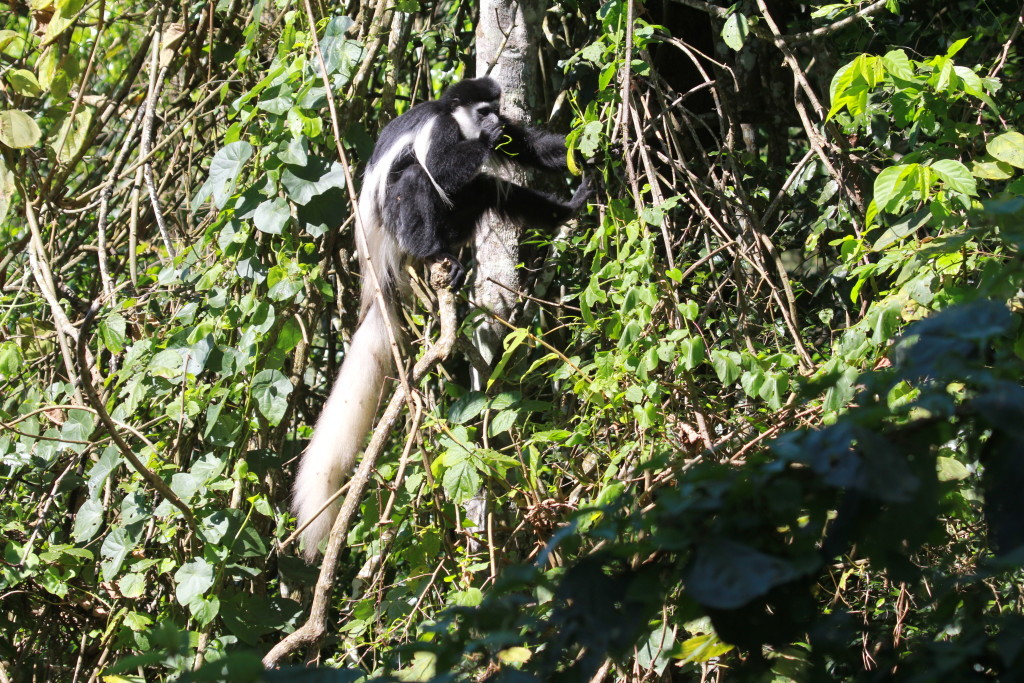
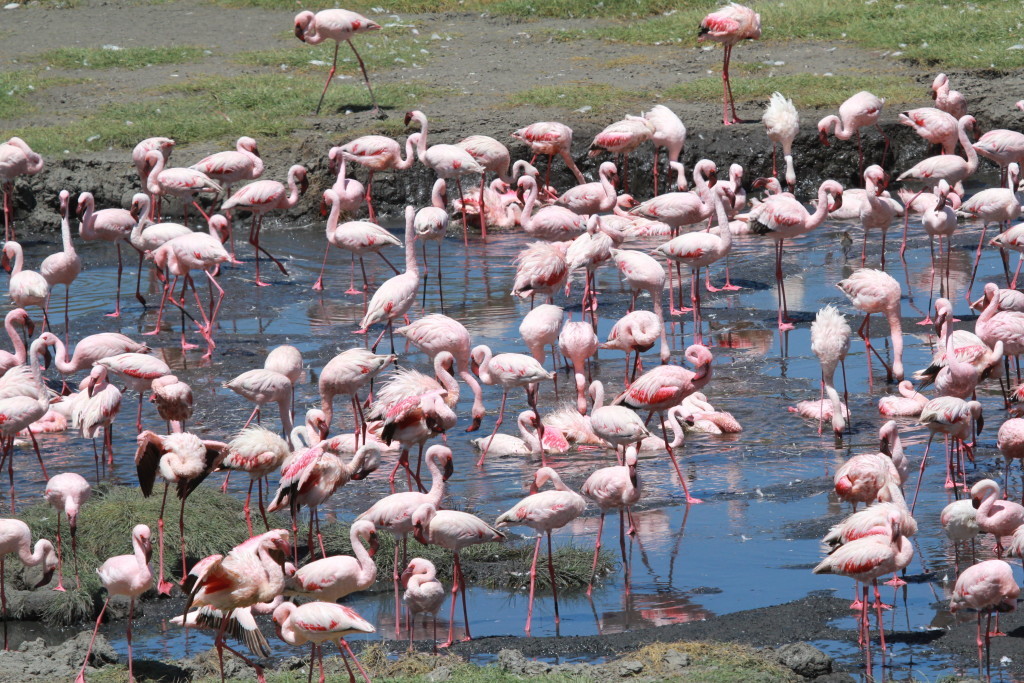
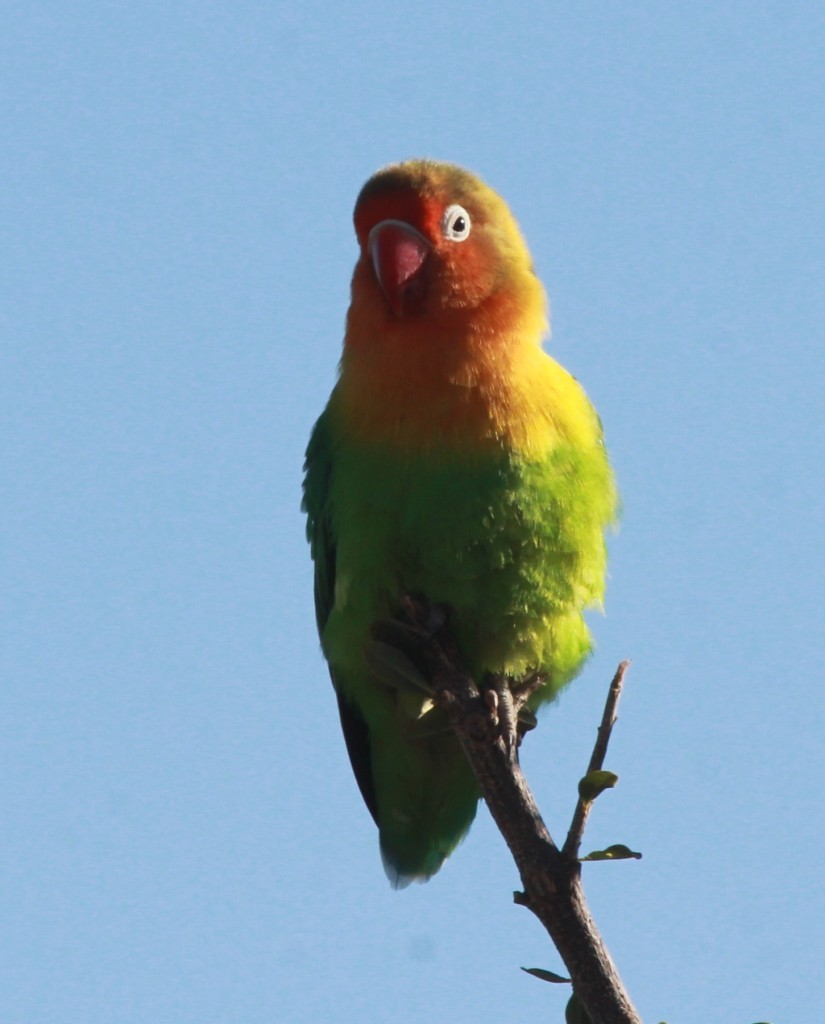

With Christmas in 5 days I know everyone is flat out but take a couple minutes to enjoy these beautiful photos taken on a safari in Tanzania – then plan one for yourself!



Everyone who is headed out for a safari in the northern Tanzania parks will be at least passing trough Arusha and most likely staying a day or two. L’Oasis is located in a quiet area on the outskirts of town and a short walk from a main road where you can get public transport.
Sadly Henry the Crested Crane was killed by a neighborhood dog last year. I had really been looking forward to seeing him as he liked to hang around the swimming pool.
The staff are very friendly and helpful. In the right, you can see a small library if you are looking for a book to pass the time. The power went out several times while we were there (the whole town, not just the lodge) so it was nice to have books! The internet is strongest near the reception but we had the nearest bungalow which also picked up the wifi signal.
They have a small souvenir stall. That painting of the Superb Starling came home with us and is now in our living room!
This is a dining room/bar/lounge area where you can just relax or order something from the menu which will be brought up to you. The hamburgers were delicious!
Here’s the pool by day and by night.
The bungalows are really cute! I loved the African decor and the towel animal!
The ensuite
Breakfast is included in most room rates and offers a good selection of eggs, fruit, bread and jam. The artwork on the wall was really nice.
A few birds hang out, probably more but we left really early so didn’t have time to see more birds at the lodge. Mostly little Weaverbirds and Bulbuls.
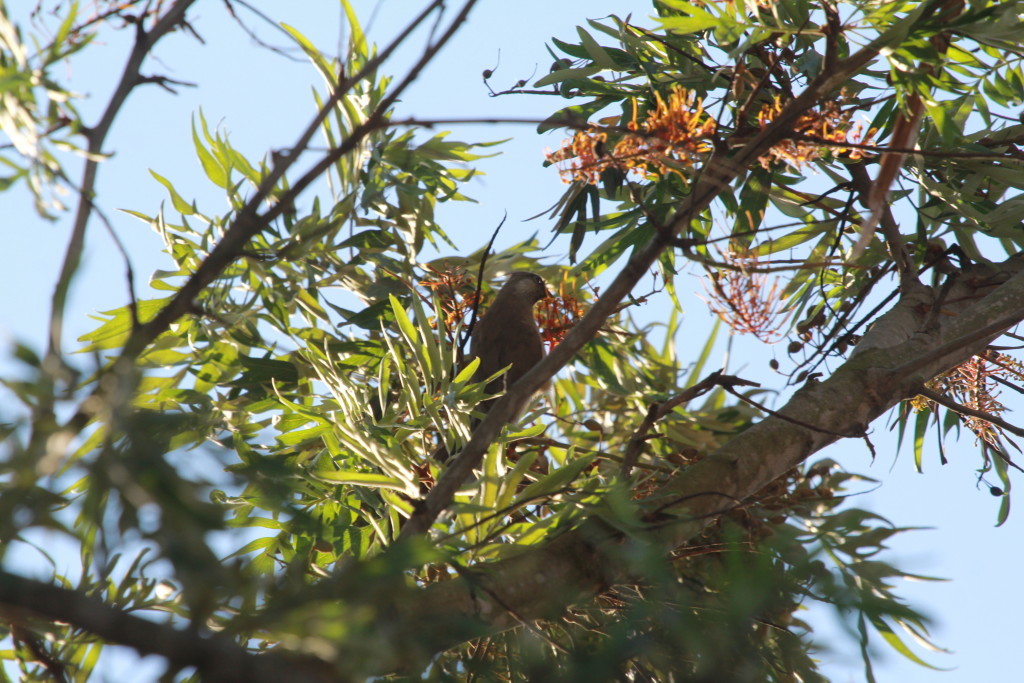
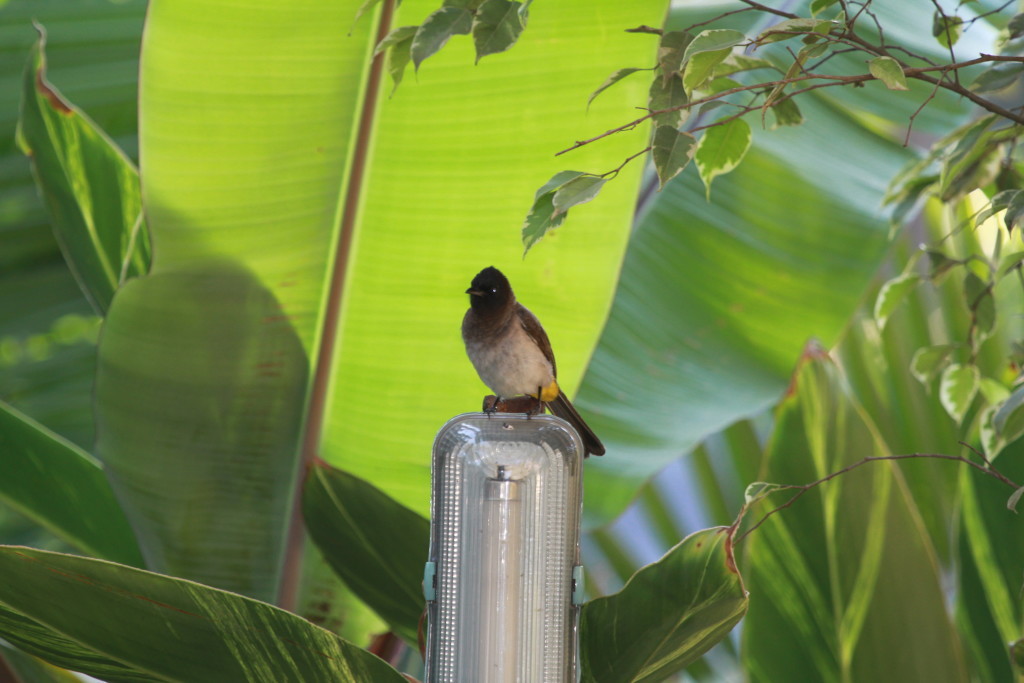
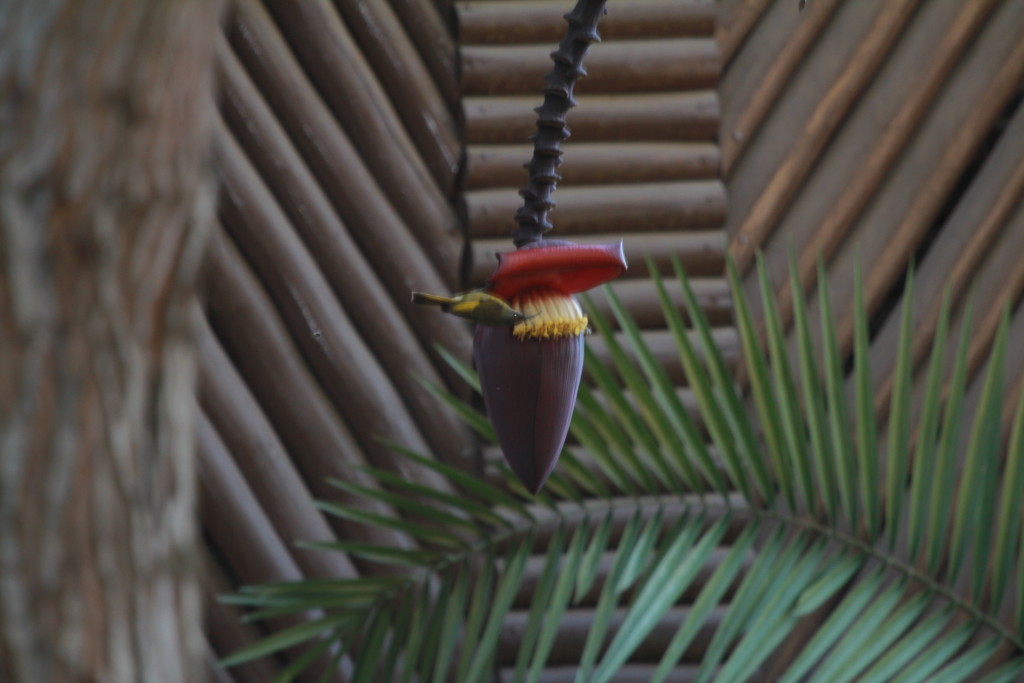 You can book either through their website or try Booking.com if you have a good click-through portal. Sometimes Booking.com is cheaper. You pay at check out and they do take credit cards when the power is on. If the power supply is dodgy, best to pay the night before if you need to use a credit card.
You can book either through their website or try Booking.com if you have a good click-through portal. Sometimes Booking.com is cheaper. You pay at check out and they do take credit cards when the power is on. If the power supply is dodgy, best to pay the night before if you need to use a credit card.
This is a fantastic little eco-lodge very convenient to town if you need to go there (we didn’t but you might). It has real African character and we really enjoyed our stay!
Arusha National Park is often bypassed in favour of the larger parks like Serengeti & Ngorongoro but it is well worth a visit whether you are a birder or not. For one thing, the views of Mt Kilimanjaro are amazing from here! Thoughout this post, you will see several angles of Kilimanjaro taken from different locations as the photos are posted in chronological order.
I asked Fortes whom I had booked the car/driver package with but they wanted to charge the same amount for a day trip as they did for the multi-day trip which had included allowances for the driver’s food and accommodation. I thought I could get a better price so I rang a few places from the hotel and finally booked a different car/driver for the day. One annoyance for me as an Australian is that tour operators kept quoting in USD even though I would have to withdraw cash Tanzanian Shillings from the ATM from my Aussie bank account.
An easy 40-minute drive from Arusha. Approximately 60 km (35 miles) from Kilimanjaro International Airport. The lakes, forest and Ngurdoto Crater can all be visited in the course of a half-day outing at the beginning or end of an extended northern safari.
After you enter the park, you will see the reception where you pay the fees. They take Visa & Mastercards.
The jeep and the contact details as per their logo.
Before heading off, you can use the toilet and check out the information boards.
I am not going to be able to find all these birds in my 800 page book, especially when the LBJs are so similar, not to mention female birds whose partners are more colourful. I’ll do my best!
Little Bee-eaters
There is a museum with some taxidermied displays of birds.
Colobus Monkeys – the flagship species of ANP.
Collared Sunbird
The driver takes a break while we chill out at the lookout point.
Blue Monkey
Little Bee-eater
1000’s of Flamingoes
African Hoopoe
Picnic area
Heuglin’s Masked Weaver
I wasn’t happy when a school bus full of noisy kids showed up.
Siesta time!
Common Bulbul
Collared Sunbirds
Somewhere around here was where the Jardine’s Parrot shot out of a tree overhead and disappeared into the dense forest. I tried a Hail Mary shot but failed to get him.
The drive back to Arusha was anti-climatic. The driver tried to steer us to shop at a couple stalls but we already had enough stuff and I knew he was angling for a commission from certain stalls.
A pink church
Trumpeter Hornbill
Cultural Hertitage Centre back in Arusha
A mosque in Arusha
Interesting pub!
Heading to our hotel on the back roads
Having some time to kill, I got my hair braided in one French braid.
Ina got a shave.
The Beautiful Sunbird (Cinnyris pulchella) (formerly placed in the genus Nectarinia), is a sunbird. The sunbirds are a group of very small Old World passerine birds which feed largely on nectar, although they will also take insects, especially when feeding young. Flight is fast and direct on their short wings. Most species can take nectar by hovering like a hummingbird, but usually perch to feed most of the time.
The name and the description are the same. I managed to get a few good photos in Ndutu and Tarangire.
The much duller female
They have a large range stretching from the West Coast of Africa to Ethiopia in the east and as far south as Tanzania. Look for them in flowering plants in lodges, they seem to know a good free feed when they see one! The red dot shows Ndutu where I had my best sighting.
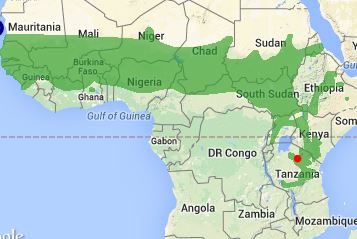 LEARN MORE ABOUT BEAUTIFUL SUNBIRDS
LEARN MORE ABOUT BEAUTIFUL SUNBIRDSThere are a few clips from the Gambia on IBC as well as this one from YouTube.
The Fischer’s lovebird (Agapornis fischeri) is a small parrot species of the Agapornis genus. They were originally discovered in the late 19th century, and are named after German explorer Gustav Fischer.
I managed to get up close and personal with some at Ndutu Safari Lodge where they frequent the garden and small pond near the dining room.
Trying to catch one in flight – turned out blurry.
Nesting site just outside the lodge.
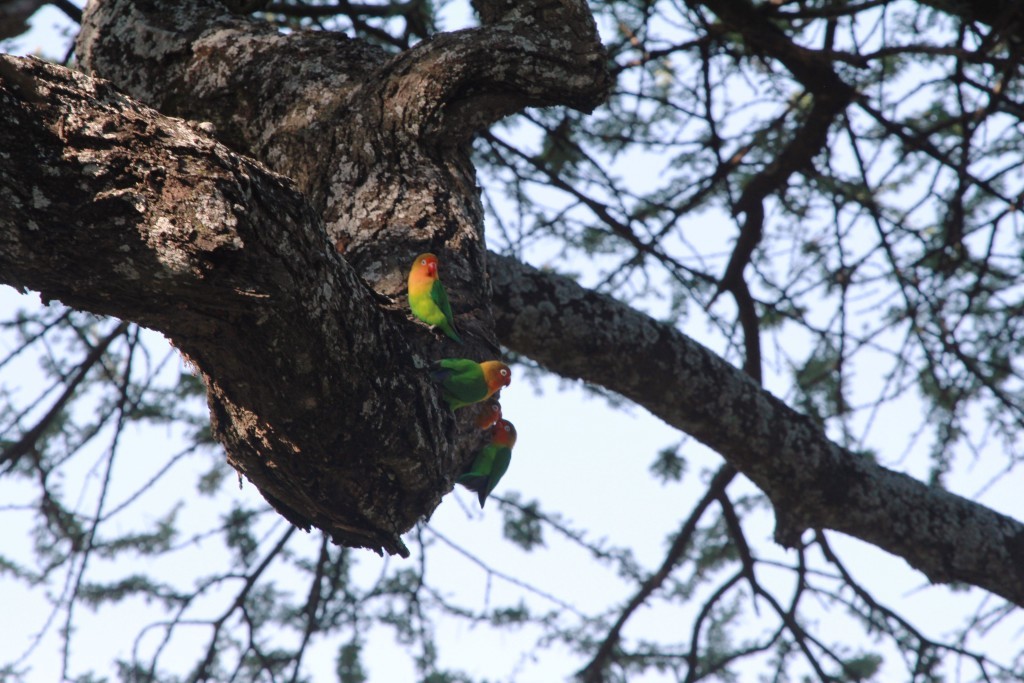
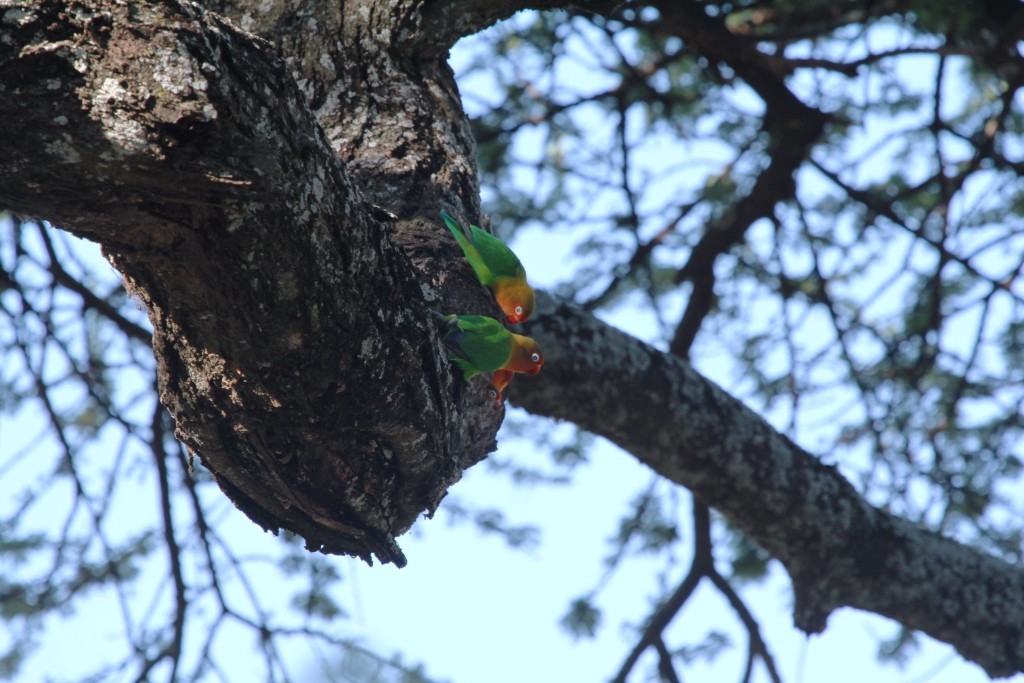
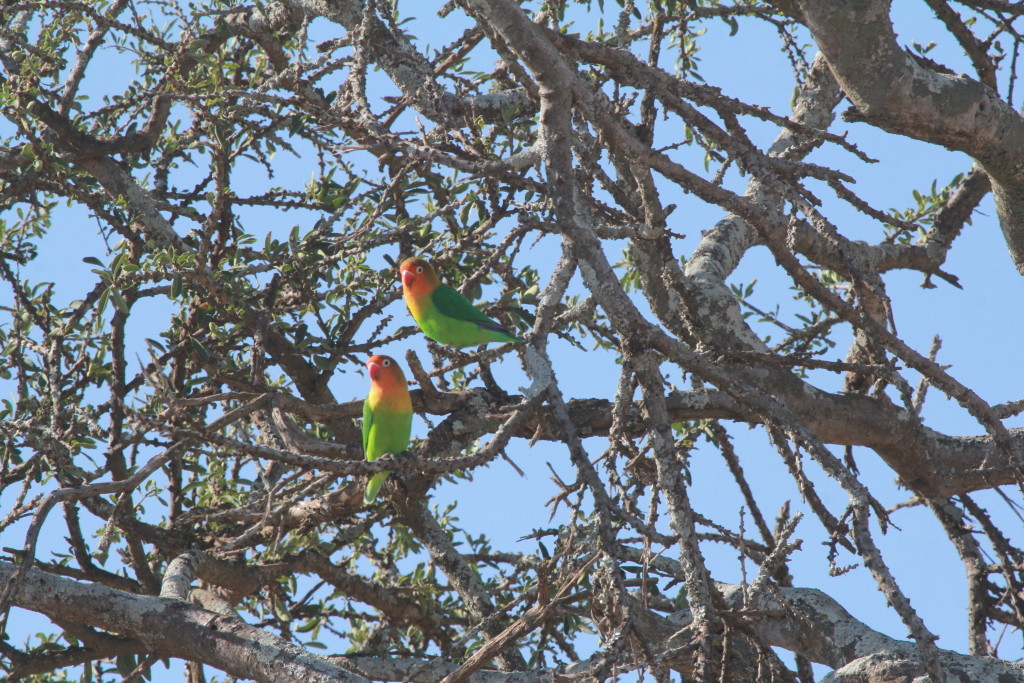
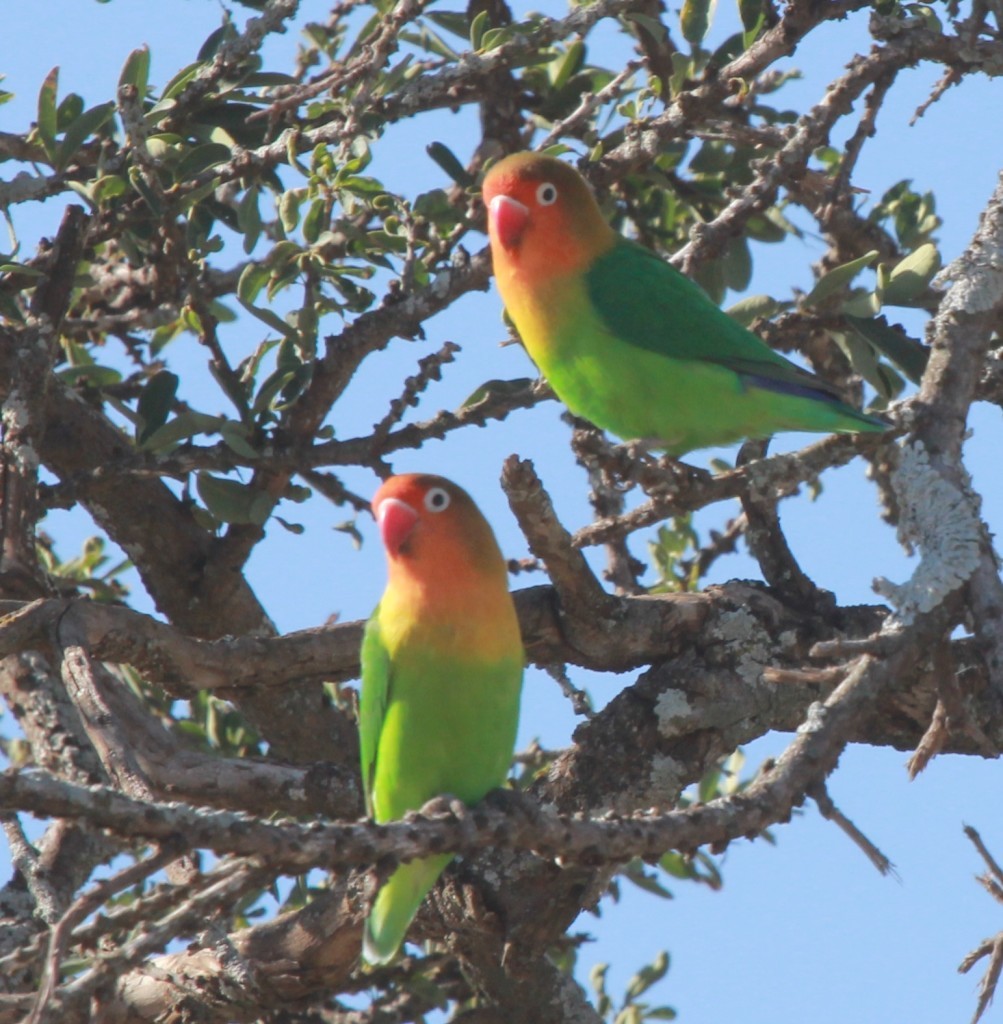 Most of their range is in Tanzania but they do extend into Kenya a bit. The best place by far to practically guarantee good sightings of Fischer’s Lovebirds is Ndutu Safari Lodge (red dot) in the Ngorongoro Conservation Area in Tanzania. Some people on Xeno-Canto have reported sightings in Lake Navaisha, Kenya – see below.
Most of their range is in Tanzania but they do extend into Kenya a bit. The best place by far to practically guarantee good sightings of Fischer’s Lovebirds is Ndutu Safari Lodge (red dot) in the Ngorongoro Conservation Area in Tanzania. Some people on Xeno-Canto have reported sightings in Lake Navaisha, Kenya – see below.
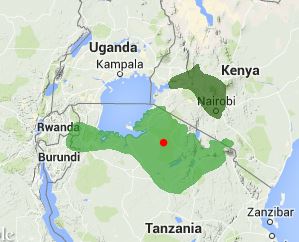 LEARN MORE ABOUT FISCHER’S LOVEBIRDS
LEARN MORE ABOUT FISCHER’S LOVEBIRDSThis was filmed at Ndutu Safari Lodge, the same place I was.
If you are under 18, stop here. If you are not, see the following two videos to see how Lovebirds got their name!
These are captive bred birds but LOL at the satisfied reaction of the male! And his girlfriend just wanted to dig a hole and disappear!
Continuing on from Part 1, we are starting with an early morning game drive before breakfast. Some Thompson’s Gazelles were grazing at the pond which straddles the border with Serengeti.
Flamingoes make a nice reflection.
Mourning Dove
Blacksmith Plover
Grey-breasted Spurfowl
Lilac-beasted Roller
This next batch of photos covers the drive after breakfast as we leave the lodge and start the drive back to Arusha. Fischer’s Lovebirds were there to say goodbye.
This mixed herd of Wildebeest and antelopes is just a tiny fraction of what you see during the great migration.
Ostriches
Silver-backed Jackal
Drongo
Vultures cleaning up someone’s dinner from last night.
Camels generally belong to Masai people.
Closer to the gate we start seeing our friends the Little Bee-eaters and Weaverbirds again.
One last look at the crater
And time to say goodbye to the NCA. But not without drama! We were 8 minutes overdue for leaving although the clock on the car and both our phones – mine & the drivers said we were 5 minutes early. They let us go but not without a sound scolding!
Lesson learned – synchronize your watches when you enter and don’t cut it too close!
The Secretarybird or Secretary Bird (Sagittarius serpentarius) is a very large, mostly terrestrial bird of prey. Endemic to Africa, it is usually found in the open grasslands and savannah of the sub-Saharan region. Although a member of the order Accipitriformes, which also includes many other diurnal raptors such as kites, buzzards, vultures, and harriers, it is given its own family, Sagittariidae.
They are probably one of the coolest birds around with their head quills and they hunt snakes. Anyone who helps rid the world of snakes is OK in my book!
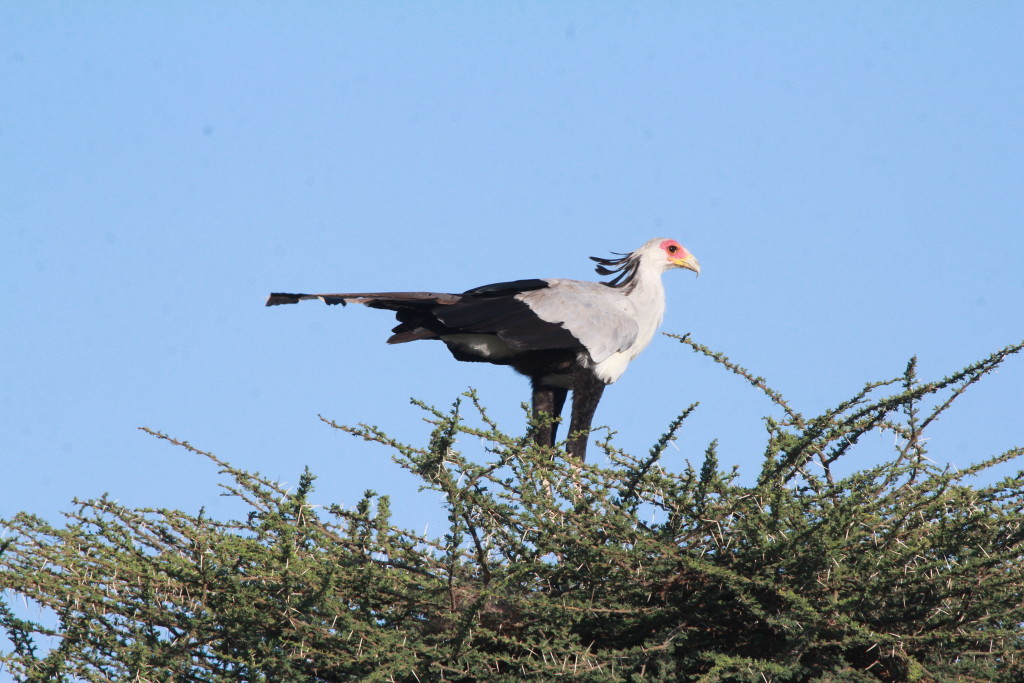
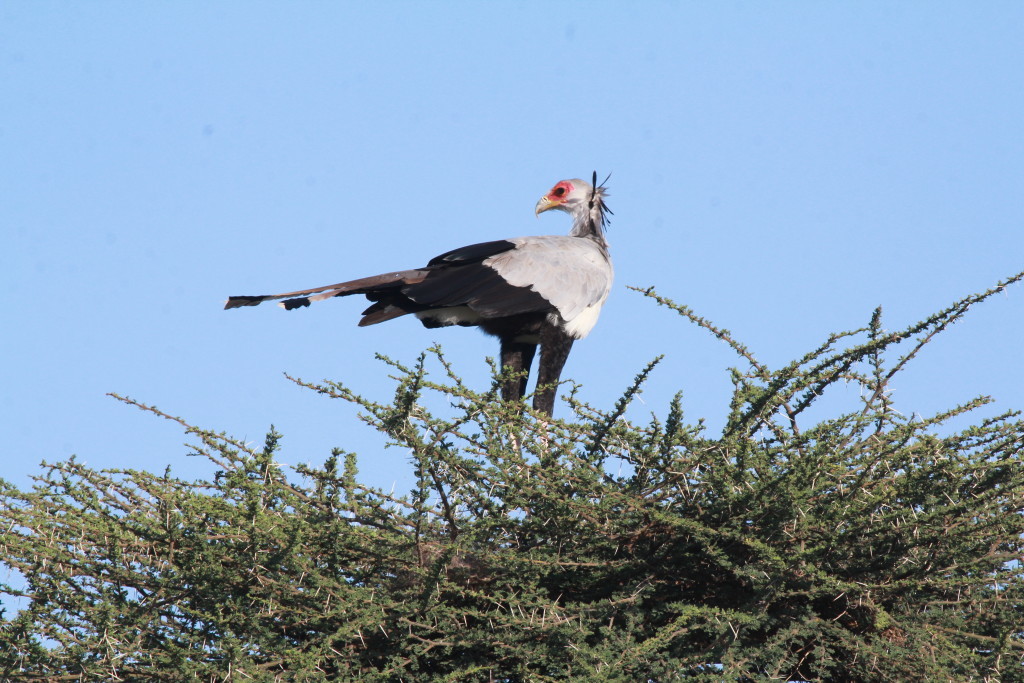
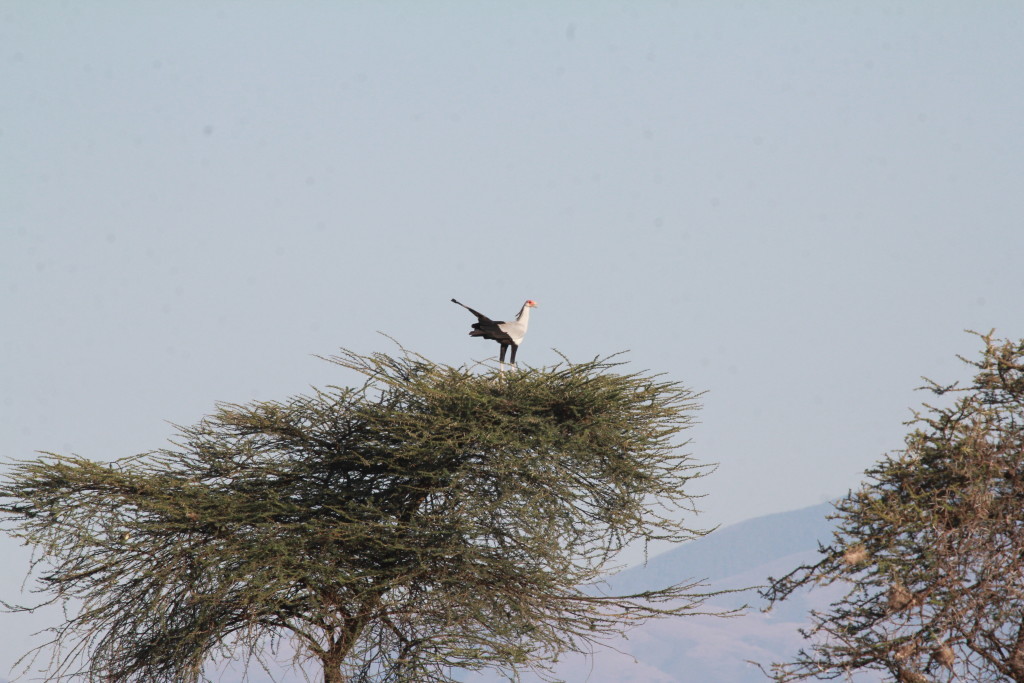
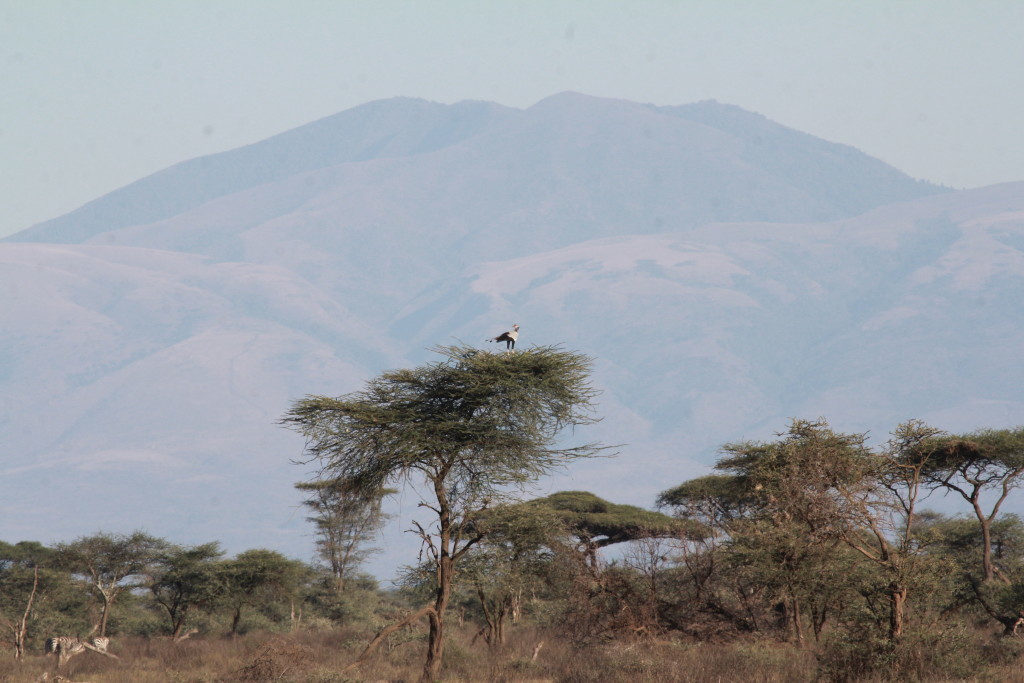
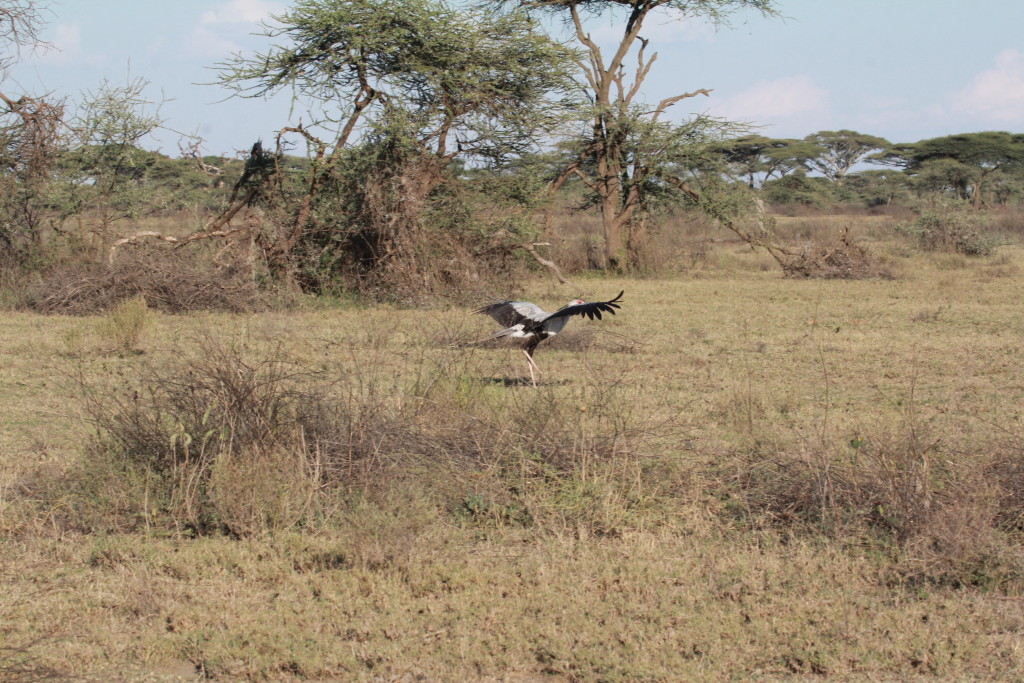 Secretary birds have a huge range and can be seen in just about any of the popular national parks in Africa. I have personally seen them in Kruger, Kgalagadi, Masai Mara, Serengeti and most recently in Ngorongoro near Ndutu.
Secretary birds have a huge range and can be seen in just about any of the popular national parks in Africa. I have personally seen them in Kruger, Kgalagadi, Masai Mara, Serengeti and most recently in Ngorongoro near Ndutu.
Sort clip from a documentary.
Another snake bites the dust!
The first thing I saw on their home page was a photo of lots of vibrant Fischer’s Lovebirds – and I knew we had to stay there. Ndutu Safari Lodge didn’t disappoint either in wildlife nor in facilities. It was awesome!
Prices are very reasonable for this part of Tanzania, I think you save a bit by not actually entering Serengeti NP but by being on the border in the NCA with similar wildlife. After seeing all the birds in the area, I wish we could have stayed longer than the one night.
As you enter, you see the reception area and the rear of some rooms as the rooms face a plain where you can watch wildlife.
They have a shop but it was closed by the time we arrived.
They have an excellent display of informational boards about the wildlife to be found in the lodge surrounds.
Nice to see which birds to look for!
Here is our bungalow with the backpacks sitting outside. Yes, that really is ALL we traveled for a month in Africa with!
This room could hold up to 4 people but it was nice to have extra room to sort our stuff out.
Coffee & tea is provided but there are better varieties of both in the dining room.
The bathroom was huge!
Storage cabinet, thankfully we didn’t need the umbrella.
This bungalow is actually a duplex and the closest one to the dining room and the pond where the lovebirds come to drink, I had requested this.
Most people get at least a breakfast and dinner package as there is no where else to eat. The food was really good. Don’t forget to try some of the exotic teas!
The garden was gorgeous and apparently this sunbird agrees! I think it’s a female by the colour.
Caution not to go beyond a certain point, there are wild animals out there!
Fischer’s Lovebirds! They were readily seen around the lodge and not afraid to pose for photos.
Scarlet-breasted Sunbird
Caught in the headlights – now you know what it really looks like!
The resident Genet. These guys are not cats as some people call them, you can tell by the face. This one is a mother and I caught a glimpse of her baby but he wouldn’t come out for a photo. Genets are very elegant and graceful and it was fun to watch her antics during dinner. She caught and ate a large moth.
A well-named Beautiful Sunbird
The best thing to do at Ndutu is to stake out this little pond and see who comes in for a drink. It’s within sight of the dining room so have a leisurely breakfast and coffee and enjoy the show!
Laughing Doves
Nubian Woodpecker
Beautiful Sunbird
Inquisitive Fischer’s Lovebird
Bathing beauties!
Another educational poster at the lodge.
The Ngorongoro Conservation Area (NCA) is administered separately from the Tanzanian National Parks with separate fees. If you are headed to Serengeti, you have to pass through NCA first and pay both sets of fees! They aren’t cheap either at $50 per foreigner per day. There is also a fee for the car and driver which are paid at Tanzania rates (unless you come in with a foreign car) and will usually be included with your car hire or safari package. If you want to go into the crater, it’s another $200 on top! I had been in the crater back in the 90’s in my backpacking/camping days and I knew the birds would be easily seen up top so we didn’t pay the extra for the crater. Days are periods of 24 hours so if you enter at 12 noon, you must leave before 12 noon. Mid-day is the best time to enter as it gives you time to view the crater, have lunch at the picnic area and get to your lodge in time for an afternoon game drive. Then you have the next morning to do another game drive, have breakfast and get back to the gate before time runs out.
This is where you pay the fees or your driver-guide does it on behalf of all of you. There’s a small shop, a few displays of animals and clean toilets.
Little Bee-eaters
Baboons
There is a nice viewpoint where you can hop out, walk around in the vicinity and get a great view of the crater. There are also toilets at this area if you need them. It’s about 20 min from the gate.
The picnic area wasn’t the best, no tables and benches like the one at Tarangire. These little Weaverbirds kept us entertained while we had lunch.
Sorry, we don’t have room for hitch-hiking giraffes!
There are Masai people living in the NCA and grazing their herds here which is different from the other national parks.
Directions to some of the lodges in NCA including ours – the Ndutu Safari Lodge.
Egyptian Goose
After checking in at the lodge (which I will blog about separately), we headed off on a short game drive. Be sure to check what time you have to be back in the lodge grounds, it will be around dusk but varies according to time of year.
Lilac-breasted Roller
D’Arnaud’s Barbet
In the distance, one of my all-time favourites – a Secretarybird poses majestically, then flies off.
Superb Starling
Sorry, I can’t find this guy in the bird book but he looks like he got lost on his way to the ski slopes! I mean seriously, check out those fluffy boots!
Superb Starlings in flight
Another group got to the Maribou Storks first. The land across the lake belongs to Serengeti NP and in some places the border weaves in and out. You have to be careful to stay inside the park boundaries you paid for!
European Roller
Hildebrandt’s Starling
And the sun sets on yet another wonderful day!